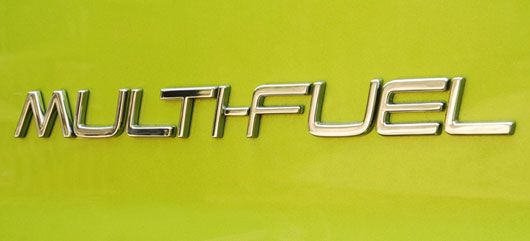Volvo Multifuel
 Volvo has developed a new Multi-Fuel prototype car, optimized for running on five different fuel types. The Volvo Multi-Fuel is a five-cylinder, 2.0-litre prototype car (200 bhp) that runs on: hythane (10% hydrogen and 90% methane), biomethane, natural gas (CNG), bioethanol E85 (85% bioethanol and 15% petrol) and regular gasoline. The new concept is introduced at the Michelin Challenge Bibendum 2006 and is one of its kind.
Volvo has developed a new Multi-Fuel prototype car, optimized for running on five different fuel types. The Volvo Multi-Fuel is a five-cylinder, 2.0-litre prototype car (200 bhp) that runs on: hythane (10% hydrogen and 90% methane), biomethane, natural gas (CNG), bioethanol E85 (85% bioethanol and 15% petrol) and regular gasoline. The new concept is introduced at the Michelin Challenge Bibendum 2006 and is one of its kind.
Volvo Multifuel emblem. A new Multi-Fuel prototype car, optimized for running on five different fuel types.
“Volvo believes that the road to the future is not one but many,” the automaker explained. “No renewable fuel type can alone replace the fossil fuels of today. Since local conditions vary, different markets need engines for different alternative fuels, together with cleaner conventional ones. With this in mind, Volvo Car Corporation has developed the Multi-Fuel, a prototype car that can be powered by five different fuel types, thus be driven on the energy source at hand – anywhere in the world.”
The Multi-Fuel vehicle contains one large and two smaller tanks of totally 98 litres for gaseous fuels (hythane, biomethane and CNG), and one 29-litre tank for liquid fuels (bioethanol E85 and petrol).
The fuel tanks are fitted neatly under the luggage compartment floor, which means that full loading capacity is preserved. Two fuel fillers are used to fill up all five fuel types, one for gaseous and one for liquid fuels. The engine automatically adjusts itself to the right blend of gaseous or liquid fuels. To switch between fuel types, the driver simply presses a button.
The Multi-Fuel has a motor effect of 200 bhp and accelerates quickly up to speed, 0?100 km/h in 8.7 seconds. This makes the car more responsive and smooth to drive. ? The Multi-Fuel is turbo charged to achieve performance on any of the five different fuel types.
The Multi-Fuel is remarkably clean and meets the emission standards for Euro 4 and the proposed levels for Euro 5. An alternative catalyst system has also been developed to meet the tough demands on extremely low tailpipe emissions for PZEV/SULEV on the US market. The vehicle has two catalysts, one close coupled to the engine that lowers initial start emissions, and one under the floor for reduced high-speed emissions. The double catalysts and advanced engine control system lead to very low emissions. High-temperature materials in the exhaust manifold and turbo allow extremely high exhaust gas temperatures of up to 1050 ?C. This enables the car to run cleaner, accelerate quicker and operate smoother at higher speed.